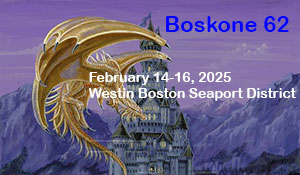Beguilement (The Sharing Knife, Vol. 1)
by Lois McMaster Bujold
Eos, 2006, ISBN 978-0-06-113758-7
This is Bujold’s new fantasy, or the first half it anyway, and it’s well worth the wait. Fawn Bluefield, a young woman from a prosperous but not wealthy farm family, is two months pregnant, and fleeing the disgrace, and even worse the embarrassment, of having her condition discovered while her lover marries the only daughter of a much wealthier neighboring farm family. Traveling on foot to Glassforge, a large town several days away, where she can be anonymous and find work, she has a near encounter with a group of the somewhat mysterious Lakewalkers, who patrol the settled farm areas and the wilderness around them. Not long afterward, she has a much more dangerous encounter, with “bandits” who turn out to be the agents of what farmers call a blight bogle and Lakewakers call a malice. The Lakewalker patrol Fawn saw earlier was malice-hunting, and one of them, a one-handed man called Dag, rescues her from them, deposits her safely (he thinks) at an abandoned nearby farm, and returns to the hunt. Unfortunately, because she’s pregnant, the malice really wants Fawn, and its servants come back for her and drag her off to the malice. Dag, because of his previous detour on her behalf and his tracking of the escaped malice-servants, reaches the same spot not long after. In the ensuing fight, temporarily fully occupied with the malice’s servants and tools, he tosses Fawn his two bone knives, and that’s when things start to go really strange for both of them.
One of those knives was properly primed to kill a malice. The other one wasn’t; it was waiting to be primed, with Dag’s death. A Lakewalker would have known which was which, while Fawn didn’t even know that there should be a difference. She used one knife, with little apparent effect, and then the other, successfully. Afterwards, Dag finds that the unprimed knife is now primed—with the death of Fawn’s unborn child. And Fawn is suffering a miscarriage.
Fawn and Dag are now tied together by the puzzle of that knife. Fawn isn’t willing to go back to her family, and Dag believes it’s vital to take that knife, and Fawn, to more knowledgable heads among the Lakewalkers, to figure out what’s happened and what to do about it. After a few days at the nearby farm (whose owners return, now that the malice is dead) while Fawn recovers enough to travel, they go on to Glassforge, where Dag’s patrol will be gathering to regroup.
Over the next several weeks, Dag and Fawn, each very vulnerable in their separate ways, grow closer and closer—much to the dismay of both Lakewalkers and townsfolk (“farmers” to the Lakewalkers, who apply the term to all settled people) who notice. They also have a great deal to learn about each other, and each other’s culture; there’s ignorance and arrogance on both sides, lying between Lakewalkers and farmers. The farmers and townsfolk who know the malices/blight bogles are real acknowledge some debt to the Lakewalkers who hunt and kill them, but only to a point, and many don’t believe in them and suspect the Lakewalkers of necromancy and even cannibalism; the Lakewalkers, dependent on the settled people not only for a good part of their provisions but also for tools and equipment that simply can’t be manufactured by nomadic tent-dwellers, nevertheless regard the “farmers” as stupid, unimaginative, and largely useless when they’re not being a burden. The easy communication between Dag and Fawn doesn’t make their relationship with each other or their return to Fawn’s family any less complicated. It’s not really possible to say much about the second half of the book for someone who hasn’t read it yet. It’s superficially quite straightforward, and actually fairly complex.
And yes, this is the first half. Read it anyway.
Highly recommended.







 Donate to NESFA
Donate to NESFA